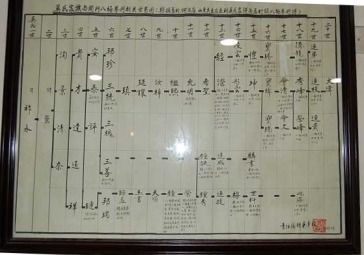Origins of the Wu Family
The history of the Wu family starts in the early Ming dynasty. During the first year of the Ming dynasty Jianwen Emperor (i.e. 1399), ZhuDi (朱棣)the prince of Yan kingdom raised troops in order to take JianWen emperor's throne by force. CangZhou and its vicinity suffered from the turmoil caused by war, a large part of the land was bared, and only one percent of the people did survive. In 1402, ZhuDi accessed the throne and became the famous YongLe (永乐) Emperor of Ming dynasty. He then ordered people to be massively deported in order to reclaim the bared land.
As a consequence, during the first year of Yongle's reign (i.e. 1403), the respectable Wu ZuoYong (吴祚永), a Hui minority ancestor of the Wu Family, received a specific imperial order requesting him to serve as an employee at the CangZhou's salt transport service of the government office of Hejian city, Hebei (at that time called Zhili) province. He moved his whole family from Anhui province, HuiZhou prefecture, Xi county, to Cangzhou, and settled in the south of CangZhou (see Map of MengCun area for details). From then on, the Wu Family developed in CangZhou and went rich and prosperous.
One after another, the Wu family descendents purchased properties in the actual MengCun town of MengCun county, in the HeLüDian hamlet, in the XiaoLu village of HaiXing county, in the BaoGuanTun village of NanPi county, in the WuZhuangZi hamlet in HuangHua city, and in the HouZhuangKe village in the QingYun county of ShanDong province (at that time belonging to CangZhou) and another large number of places. Among the ancestors of the Wu family, an ancestor of the fourth generation (considering Wu ZuoYong as the first generation), the venerable Wu Cai, (吴才) got four children named Wu An (吴安), Wu Tai (吴太) , Wu Ping (吴评) and Wu Lian (吴琏) who had trouble living together in CangZhou. As a consequence, Wu Tai and his children called Wu SanTong (吴三统), Wu SanHuai (吴三槐) and Wu SanShan (吴三善) moved to MengCun town, whereas Wu Lian and his family moved to He LüDian (何吕店, a hamlet located 4km north-east of MengCun town). From this time, Wu Tai and his descendants founded the MengCun town branch of the Wu family, whereas Wu Lian and his descendants established their families in HeLüDian and in MengCun DongZhuang (MengCun east hamlet). Later, one of the grandson of Wu Lian, called Wu ShiMeng (吴师孟) , moved from the HeLüDian/MengCun area to HouZhuangKe, and founded the Hou ZhuangKe sub-branch of the Wu family. As a consequence, all the people living in MengCun, HeLüDian and HouZhangKe and bearing the Wu family name are the descendent of the fourth generation ancestor Wu Cai. Among the descendant of Wu ShiMeng, there was a great grandson (tenth generation) called WuZhong (吴钟), nicknamed HongSheng (弘声), son of Wu TianShun (天顺) and born in the 51th year of KangXi (i.e. 1712), who represents the most ancient BajiQuan practitioner from the Wu family known at this time (see History of BajiQuan).

